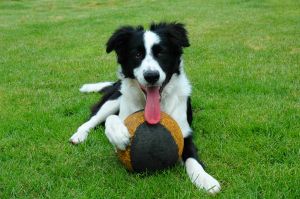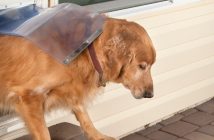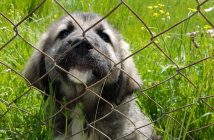by Jeff Nenadic
Oftentimes considered the most intelligent of all breeds of dogs, the Border Collie originated in the English and Scottish border country, and is an excellent sheep herding dog. They were plentiful in numbers in England and Scotland during the 1800’s when they were used as fetching dogs in order to circle sheep herds and keep the animals close to the shepard. By 1873, sheepdogs known as Border Collies and became extremely well known when the breeds character was tested at the first official sheepdog trial in England.
The first known Border Collie on record, tested at this trial, was a male named Hemp. He was used to sire more offspring and has oftentimes been referred to as the Father of Border Collies for this reason alone. Hemp used a combination of eye contact and fear in order to herd the flock, and was considered the most intelligent dog of his day in the British Isles.
Despite the fact that the breed had been recognized since the 1800’s, the name Border Collie was not deemed as the official breed name until 1915. Sheepherders in the U.S. who were in dire need of a smart herding canine welcomed the Border Collie with open arms upon their arrival in North America. Unfortunately, where the AKC is concerned, they were never considered as a competitive show dog until the mid 1990’s.
The two primary traits of the Border Collies personality are obedienc and intelligence. Unfortunately, if they are kept indoors too long and not tended to, they can become rather destructive in their efforts to entertain themselves and stimulate their brains. Additionally, the Border Collie at times will display an aloof, guarding type of behavior as they are extremely loyal and protective. And this behavior is exhibited the moment a strange human, dog, or other animal gets too close to their masters.
 Mental and physical stimulation on a day to day basis are critical issues with Border Collies and many breeders and dog experts have the tendency when appraising the dogs personality to say that the breed simply has a job to perform. So they will take advantage of any such opportunity as it arises. In so many words, this dog has been genetically programmed to perform a multitude of work functions.
Mental and physical stimulation on a day to day basis are critical issues with Border Collies and many breeders and dog experts have the tendency when appraising the dogs personality to say that the breed simply has a job to perform. So they will take advantage of any such opportunity as it arises. In so many words, this dog has been genetically programmed to perform a multitude of work functions.
Despite their desire to be indoors with their families, they are quite capable of tolerating mild to cooler weather conditions. As the breed requires significant amounts of room to roam around for exercising, it is ill advisable that you subject the dog to an apartment like environment. In fact, the more astute breeders will deter you from obtaining one if you reside in an apartment, condo, or studio type residence.
Border Collies have been known to live as long as 15 years, but 12 years is their average lifespan. Fortunately, there are no major health concerns with this breed so you do not have to worry about anything unforeseen arising during the dogs life. The only issue on rare occasions is CHD, Coronary Heart Disease. Minor health issues include CEA, hypothyroidism, lens luxation, OCD, PDA, PRA, and seizures, but these conditions are rare and seldom occur with any documented regularity.

My-DogShop.com has a huge selection of over 300 dog grooming tools and dog grooming supplies.




7 Comments
It is thought that the original direct ancestors of the present day Border Collie were developed during the period of the Border Reivers, between the 14th and 17th centuries, a time when the border lands of England and Scotland was a greatly disputed and lawless region, ignored by government on both sides and left to fend for itself with its own laws, customs and wardens in control of 6 regions, called ‘Marches’, three on either side of the Border.
These marches were frequently subjected to the ravages of Scottish and English armies passing through to invade the other side, ravishing the land, looting, stealing crops and stock to feed themselves and making it impossible for the people of the region to live a productive life as any crops they planted were not likely to be left in the soil when it came to harvest time.
As a consequence, the local inhabitants, led by clan leaders, developed a lifestyle of raiding each other, stealing livestock and booty, in order to put food on their tables. These folk became known as the ‘Riding families’ and more generally as the Border Reivers.
Livestock was the wealth of the residents of these regions, and consequently the target of most raids, however the penalties of being caught in possession of stolen stock were severe – and often terminal – so developing an intelligent working stock dog that was capable of driving stolen stock back to its masters land – alone – became a good way of avoiding being caught red handed.
As most raiding occurred after dark, a black dog with a white front would be invisible to pursuers, but still seen by the stock it was driving and was thus a popular choice. The dog needed to be intelligent enough to bond to its master and know when to leave stock if the pursuit came too close and fade of into the landscape.
The Collie dog of this time was a mixture of herding and hunting breeds, quite large at the beginning of its development, taking much of its ancestry from the Flemish sheepdogs favoured by the shepherds brought over by William the Conqueror to develop the British wool trade after his invasion in 1066.
Indigenous sheepdogs, Pointers and other hunting breeds were interbred with these Flemish dogs to introduce qualities suited to the job in hand and by the time James Stuart ascended to the throne in March 24, 1603, bringing the two thrones of England and Scotland into union, the Collie dog in popular use in the Borders had taken on a form that would be recognisable to us today.
For the next 150 years, the collie dog in the Borders was further developed as a sheepdog by the hill shepherds and farmers who worked the land on either side. In this period the true qualities of the breed we know today were enhanced and cemented. Custom and caution had made this quite a well guarded secret and the rest of the country got along as best it could with herding dogs best suited to each region and the sort of stock kept in the varied environments of the British Isle. With few exceptions, the Collie dog remained within the Borders.
The spread of the Border Collie throughout the rest of the UK began with the Scottish land clearances, starting around 1750 and peaking around1790. These were instigated by noble landowners and promoted as a method of improving their estates, but were really only a thinly veiled attempted to increase the personal profits they gained from their lands by turning vast tracts over to sheep grazing with the forcible re-location of crofters and tenants to coastal locations or abroad. Shepherds were needed to manage the sheep and many of these were imported to the highlands from the Border regions, bringing with them their dogs – the direct ancestors of the present day Border Collie.
The improvements were short lived as the dedicated grazing of sheep, replacing the mixed farming of crofters and the more effective control of weeds and bracken by cattle, caused the land to become infertile and overgrown within a few years. Subsequently the estates, originally supporting large numbers of sheep, was unable to sustain the flocks for long and many of these ‘imported’ shepherds became redundant, being forced to re-locate in search of employment like the crofters they had displaced. These were highly skilled men with highly skilled Collie dogs and many found themselves taking up employment on more productive sheep farms throughout the UK, where some of the properties of their dogs were noted as superior to local indigenous sheepdog variants.
However the local sheepdogs, having been developed over generations to suit the terrain, environment and stock, had some qualities the Collie lacked and to many, combining these qualities by cross breeding the indigenous dogs with the Collies was a logical way of improving the abilities of the dogs they needed to work their farms.
Unlike the present day shepherd, historically, shepherds held a powerful and well respected position in societies all over the world. Since the middle ages, the wool trade had been a predominant industry in the UK, bringing wealth to many families, landowners and towns. However by now the trade had started to collapse and shepherds were facing economic problems and an insecure future. This was particularly true during the 1800’s.
The industrial revolution was creating a new middle class with spare cash and leisure time and the Victorian era saw a huge development of interest in ‘hobbies’ with pastoral and rural ideals predominant as a backlash to the grim life of the new class of city dwellers.
Pet ownership began in earnest amongst middle class housewives with dog breeding clubs being formed and dog shows becoming popular with all social classes. The first organised dog show took place in Newcastle on Tyne in 1859 and spread quickly around the country, ultimately leading to the formation of the UK Kennel Club in 1873.
Although shepherds and farmers did not form a major part of these activities, sheepdog trials were developing from the informal and friendly competitions in local villages into more commercial events, favoured as a spectator sport by a public eager to imbibe an education in threatened rural activities and these began to be popular inclusions at agricultural shows.
The popularity of the Collie as a working breed was now well established and many shepherds saw the breeding and sale of their dogs as an important aspect of their future prosperity, consequently sheepdog trials developed new importance as a way of demonstrating one mans dog as superior to others, thus increasing demands for offspring.
Bloodlines were developed and competition became more serious.
Local variations of the collie dog were widespread, due to the inclusion of indigenous sheepdogs into the original border bloodlines, however a developing understanding of genetics and selective breeding (natural or contrived) clearly indicated that too much line breeding would lead to faults, so consequently owners of developing bloodlines would introduce dogs from other lines, and from original borders stock, to ensure their dogs were free of inherent disabilities.
Over many generations of line breeding and cross breeding, this has led to the huge variation of type we see in the Border Collie today.
By 1870, trialling had become a popular and of commercial necessity to its participants and in 1873, the first organised and recorded ‘international’ trial took place in Bala, Wales. Sheepdog societies were forming across the UK, dedicated to the purity of the working aspect of the breed, but there was no central focus or stud book to register individual bloodlines or dogs until the formation of the International Sheep Dog Society in 1906.
By the end of the Victorian era many of the previously popular herding dog breeds working on farms throughout the UK were being replaced by the Border Collie as a good ‘all rounder’, suited to many tasks, stock and terrains.
Breeds like the Old English Sheepdog, the Rough Collie, the Bearded Collie and the Shetland sheepdog, although still in use as herding breeds, were becoming more popular as pets and subsequently more domesticated.
Many of these breeds had been recognised and given a breed standard by the Kennel Club due to pressure of various specialist breed clubs whose breeders were anxious to gain a wider market and better price for their pups within the developing pet trade. However the Border Collie (now named as such within the ISDS) was still exclusively the breed of the shepherd and stockman. Credit for the name is attributed to James Reid, secretary of the ISDS for 32 years until1946.
The ISDS have never judged a dog by its standard or appearance, rather by its working ability. Although the studbook registers bloodlines by lineage, dogs are also admitted to the stud book by performance at trials or ‘on merit’. This has always allowed fresh blood and talent to be introduced into the breed.
Under the ISDS and its members, sheepdog trialing and the spread of the Border Collie reached a peak in the 1930’s prior to the second world war, interrupted only by the first world war 1914 – 1918. Trials winners like the famous ‘Old Hemp’ were prodigious sires of many pups exported worldwide and sheepdog trials had become a popular spectator sport, drawing in crowds of thousands.
After the disruption of World War Two, trials and Border Collies were again the focus of huge public interest in the 50’s with newspapers sponsoring events drawing audiences estimated as up to 200,000 people.
Another similar peak in exportation of dogs occurred in the 1960’s after the success at trials of the late John Richardson’s Wiston Cap (31154) in 1965.
Cap had markings that are now recognised by most people as the classic Border Collie and his image is the logo of the ISDS to this day.
He was also the sire of many offspring, being less than two years old when he became Supreme Champion.
Australia, New Zealand and the USA were the destinations of many dogs bred and exported in this era and the development of the breed as a working dog continued in these countries.
International cross breeding is not uncommon and in recent years we have seen the re-introduction of New Zealand BC lines to the UK to bring new blood to our own lines, although for the most part this has been restricted to KC registered dogs.
It was not until 1976 that the Border Collie, as a breed, was recognised and registered by the UK Kennel Club. This was, again, the result of the pressure of breeders who wished to open up new markets and gain better prices for their pups. The KC established a breed standard based on appearance rather than ability.
Many ISDS members regarded this as a death knell for the breed and in certain respects they have proved to be right, however the continued existence of the ISDS should enable enough good blood survive the eugenic principles of KC breeding practices, so there is hope that the abilities and intelligence of this wonderful breed will not be lost to future generations.
It is interesting to note that although the average life span of a KC registered BC is reckoned to be around 12 years, the average lifespan of an ISDS or working BC is reckoned to be around 16 years with many examples of dogs surviving to much greater ages on farms, 21 years not being unknown.
It should be noted that 1976 was also the year Border Collie Rescue was formed in the UK as a specialist breed rescue organisation for the welfare of the breed.
With working BC lines there are few major health concerns, Collie Eye Anomaly and Progressive Retinal Atrophy being the most serious common problems resulting in complete or partial blindness. Registered dogs are less likely to suffer from these problems due to mandatory screening involved in the registration process. Lens luxation and Glaucoma are two other inherited eye conditions, but are rarer.
BC’s from lines bred for the pet market show a greater range of hereditary problems, probably due to poorer breeding practices or inbreeding to meet a registered breed standard. These include the above but there is also an increasing occurrence of Epilepsy, Hypothyroidism, Hip Dysplasia and temperament problems, all very rare in working lines.
Pet BC’s are also prone to suffer a range of Obsessive Compulsive Disorders, conditions virtually unknown in working BC’s but frequent in pets with inherent instinct to herd and who find themselves in an environment where they cannot fulfill these instincts.
Stress related conditions such as heart disease, stroke and hyperactivity are also on the rise in BC’s kept as pets, along with repetitive strain injuries, rheumatoid arthritis and spinal problems, associated mainly with dogs involved in disciplines like agility, flyball and Frisbee. Allergies are also on the increase, with gluten intolerance being foremost.
One contributing factor to an increase in behavioural problems, other than deprivation of instinctive fulfillment, is an owner’s insistence on maintaining an intimate relationship with their BC, ensuring it has no choice but to live indoors in a busy household and not providing a proper sanctuary and space for the dog to be quiet and by itself.
This in itself induces some forms of OCD, like over protective behaviour and hyperactivity as such a lifestyle is foreign to the breed and over stimulates its natural instinctive responses. Hyperactivity also causes much damage to BC’s as the breed is naturally quiet and disciplined and is not used to the stresses caused by hyperactive behaviour.
A natural and sympathetic lifestyle for a BC would be to live outside of a heated house environment in a quiet space of its own, spending all day in some meaningful interaction with its owner and all night in its own company or in the company of other dogs.
Our human inclination to live in large social groups is also alien to the breed as the Border Collie instinctively looks for space around it and a peaceful environment. Busy towns can over stimulate BC’s as can close proximity of neighbours and active children. The breed is best suited to a rural environment.
The Border Collie is a result of hundreds of years of selective breeding which has designed the breed to be driven by a work ethic and seek a mission in life that it can carry out with a single human handler – one man and his dog.
If a BC is to be kept as a pet or companion, these factors should be born in mind as deviation from the breeds designed purpose is likely to raise problems.
In these days of commercial exploitation of the breed there is much misinformation which plays into the hands of those seeking to profit from the sale of pups or the provision of solutions to problems that arise when a dog is in the wrong type of home. Money drives the propagation of much of this misinformation. There is also the factor of human weakness and desire to consider. So many BC’s end up in the wrong environment because a human admires their qualities and wishes to own one, not understanding that the very qualities that are attractive are not going to be realised in the sort of home offered.
As the wise saying goes – “Only a non worker will make a happy pet”.
Thanks to the Border Collie Rescue Society in the UK for all of the wonderful information they’ve provided about this breed. Learn even more about the Border Collie at their website: BorderCollieRescue.org.
I recently came across your blog and have been reading along. I thought I would leave my first comment. I don’t know what to say except that I have enjoyed reading. Nice blog. I will keep visiting this blog very often.
Betty
http://smallpet.info
Check this out – If you live in an apartment, a BC isn’t for you, they definitely need some room to roam.
I’d also recommend these Border Collie training tips I found online. It took me about 20 minutes a day to work with my dog and now life with my Border Collie, Molly, is so much better. There’s no hitting, no yelling, no punishing… just sound tips meant specifically for this breed of dog: http://www.bordercollietrainer.com/.
hi,
Thanks for sharing the valuable thoughts. I am totally agree with with you.
Thanks for sharing the information again.
.-= ansh@boxers dog´s last blog ..Holy Huskies in the (dog)house! =-.
Vote for me. tq
.-= chewie´s last blog ..Doug In Action =-.
Before I read this, I had no idea that border collies needed so much stimulation to be happy in a home. It would make sense, since they are primarily used for working purposes, but they seem like a wonderful dog.